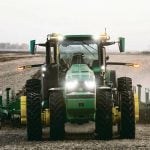New Holland’s restructured management team has launched an aggressive plan to push the company back into the spotlight
New Holland is back,” Abe Hughes II, the company’s vice-president of sales and marketing for North America declared to a group of farm writers in late April at the company’s North American headquarters in Pennsylvania.
It was just one sentence, but it is worth coming over 1,500 miles to hear. In a very real sense, New Holland had been sitting in the wings for years watching other brands go head to head.
Now, New Holland was saying they were going to climb back in the ring. The question is, can they do it?
Read Also

The Secret Sauce of Sibling Run Farms
Working with family can be difficult, but successful sibling agricultural operations seem to leverage the unique advantages of their relationships to create growth for their farms.
“We haven’t really been in the media,” said Hughes, admitting that even the company’s most loyal customers are uncertain about its strength. “We haven’t really been doing any of this.”
All through the organization, the NH team knows they’ve got a job ahead of them. “When I worked for a competing manufacturer, we kept an eye on New Holland, but we weren’t too worried about them,” said one of the members of the New Holland management team. “We thought they were asleep… and they were.”
One of the purposes of the April media event was to demonstrate the sleeping giant has awakened.
The strategy unveiled at the media briefing, intended to breathe new life into the company, is the product of an intense planning effort. “We spent month after month with senior management,” said Hughes. “We spent four or five hours (a day) for nine months from 2009 all the way to 2010 figuring out how we come up with the very best plan to reposition, restructure and rejuvenate this brand.
“One of the things that plagued this brand, if you followed it closely over the last 10 years, was there were a lot of leadership changes here, symptomatic of a company that had lost its footing,” Hughes said. “Since we acquired the Case organization we’ve been a bit out of the game. When they did the acquisition a lot of attention was focused on the other brand, and none of the attention was focused here. So it’s really over the last 10 years that we’ve struggled a bit.”
Since taking charge of NH’s North American operations, Hughes has put together a new management team and set some clear goals to build on the company’s proud history in hay tool technology, expand its equipment line and move the brand to a stronger market position.
To do that, the team took a look at where the brand was positioned in the industry, who its customers were and where it needed to go in the future to build on its strengths. “We needed to really define who are our customers,” Hughes said. “We have to have the right products for that customer base.”
For decades, the company’s core customer base has been farmers who need hay-making equipment. “We’re a mixed-farmer-focused company,” Hughes said. “This has been our traditional base of business. But along the way, this farmer has started to get more and more into cash crops. So this area has become stronger in our business. That’s where we’re pushing a lot of our growth and expansion.”
An example of the brand’s move into the grain-growing sector is the recent introduction of the two-model, self-propelled sprayer line. And it’s been a success. “We’re already above eight per cent of the market in Canada in our first year after launch,” said Hughes. The company has introduced several other new equipment models in the past two years as well. “Between 2010 and 2012, we’ve launched 15 new products,” Hughes said. “Our equipment line is really fantastic at this point.”
That’s probably true, compared to where the company has come from, but there are still some gaps to be addressed in the crop production segment; and Hughes said the company is actively working on filling them.
Figuring out which products to introduce and how to market them is where Hughes and his management team have gone their own way, compared to executive practices at some of the other major brands. Rather than designate marketing managers for specific implement lines, the NH management team has divided its overall business focus in order to concentrate on three distinct market segments: the cash crop grower, the dairy and livestock farmer, and the residential, lifestyle and contractor customer.
“It used to be that New Holland was just one big network, and we talked to our network all the same way,” said Hughes. “The more we segment our market, the more we connect with our customers.”
And just like executives at all the other major equipment brands, the NH management team recognizes any rejuvenation of the brand needs to filter all the way down to the dealer network. So the focus on targeting the needs of specific types of customers continues through to the retailers.
“We’re re-energizing our entire (dealer) network,” Hughes said. “We’re segmenting these dealers and we’re investing heavily in the dealerships. We’re looking at all the different dealers making sure they’re up to the standards we want. We’re rewarding dealers that meet those standards.”
That attention is paying off. “Our dealers are perking up,” said Hughes. “And our sales are proving that. I’m happy to say we reported our first-quarter earnings today and we beat analysts’ expectations by far.” Those earnings were nearly 40 per cent above predictions.
But even though individual members of the management team now focus on the needs and market demands of their particular segment of the industry, all of them remain cognizant of the core objectives Hughes has set for the brand overall. That means, among other things, working toward sustainable growth.
But any manager knows a company can only reach its objectives if everyone in the firm is on board with the plan. So it was necessary to also bring a renewed sense of pride and teamwork to the entire workforce at the corporate head office, not just the managers.
Walking through the offices at NH’s North American headquarters, it was impossible to miss the large wall murals reminding all the staff who their customers are and what work the company’s machines are put to. “We also began to do a cultural transition of the brand,” said Hughes. “We’ve rejuvenated the whole administration area, refreshing it, investing in employees, bringing out new benefits, offering simple things like free coffee, things that liven up the environment, really letting people know we care about them.”
At the hay tool assembly plant across the street, about 21 round balers make their way out the door each day, thanks to a $30-million upgrade. There’s a new management approach as well. “We’re tasked with achieving six to eight per cent savings year over year,” said Phoenix Rann, plant operations manager. And he said those goals are being met.
After the tour, media gathered in the foyer of the administration building to say goodbyes. It was Hughes’ last chance to get his message out, and unlike the NH of old, he didn’t miss it. “We’re back in the game,” Hughes said, confidently. CG















